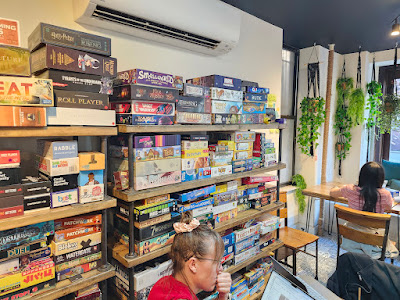Of all the board game hits I regret getting into late, it's Magic: The Gathering, the grand-daddy of all TCGs (trading card games). In 1995, I played a microscopic amount of it on the 4th floor of my Honors dorm, and didn't really get it. I was broke as hell, and the idea of buying more than a few bucks for a random deck of cards seemed ridiculous. I never really got the deckbuilding experience, and the people were playing dumb mono-colored decks, so I just didn't get it. Therefore, I never bought any of the broken rares and never traded them for a mini-van. So it goes, Vonnegut said.
I did buy into other TCGs, mostly Steve Jackson Games' Illuminati: New World Order and Chaosium's Mythos, both of which figured into existing "literature." I spent money badly and randomly, and eventually gave away or sold my small collection, tired of the effort and frustrated by the return on the time and money I had put into it. I definitely had fun, but buying booster packs was too frustrating, especially on a budget.
In 1995 I also played (Settlers Of) Catan for the first time at Nancon, run by Houston fixture Nan's Games & Comics. A wag climbed the hotel sign and changed WELCOME NANCON to WELCOME CONAN, which was about how things went. A couple buddies of mine and I went, smuggled in boxed wine in a briefcase, and played Feng Shui, a great RPG that I think got at least a second, if not a third edition. But I ended up split up, and while a Puffing Billy tournament was using train whistles to announce rounds, a guy named Marvin taught me Settlers of Catan.
It was great, I bought a copy as soon as I could (for $28), and began a collection that enchants and delights my friends, my family, and myself. Pretty good ROI (I haven't played Catan in 15 years).
In the far, far past, there was a Games magazine 100 issue in 1987. They thought a board game called Arkham Horror was amazing. Monsters came out on the map of a town, moved in a programmed way, and you tried to fight them cooperatively to save the day. I coveted it, later bought it in college too dearly, and sold it off at a small loss. It was weird-looking, and I couldn't get it to the table, so away it went.
All of that changed in 2004. We were passing my infant daughter around a game table of the "new" Arkham Horror. There was a town, monsters came out, and you fought them cooperat- yadda-yadda, but the graphics and flow had been totally reworked, and it was a much slicker experience, though, er, a little too long for me. I never bought it. I think I was playing a lot of Ra, Puerto Rico, Tigris & Euphrates, and Power Grid.
Fast forward to 2024. I take two of my kids, now in their late teens, to the inaugural ZorCon, in Lake Jackson, Texas. It was great, a pure gaming con with no merch sales. I played the updated Dune game (won as the Fremen on a coalition victory with the Harkonnen, ha!), and played Arkham Horror (the board game) 3rd edition.
AH 3e had been massively reworked, with the old staid map of 1e now modular, and with some other cute QOL updates. Our host mentioned that it was strongly influenced by Arkham Horror: the Card Game, which was not a TCG but an LCG, a "living card game" where there were no random booster packs or random decks, but instead fixed packs so you always knew you were getting a fixed amount of fun instead of gambling.
Anyway, I had an absolute blast playing Arkham Horror the board game 3rd edition, and I already had experimented and rejected Netrunner and Lord of the Rings, other LCGs. So I was primed to learn more about the cooperative LCG.
I read up on
Arkham Horror: the Card Game(2016). Within the last few years, Fantasy Flight, who put out a lot of games I enjoyed, had reworked their distribution model, for the better, by a lot. Fantasy Flight was running into a problem where they had to keep releasing product, but retailers' shelves were refusing to stretch infinitely to carry that product, let alone the poor retailers having to know minutiae.
The old way of buying: you bought two little old core sets, so you had enough cards for 4 players and had enough cards to deckbuild at all. Then there were scenarios sold in Mythos packs, of which 6 individual packages made up a whole campaign. If you liked that campaign, you could buy "Return To" packs that were sometimes basically fixpacks and remixes of the original campaigns (they didn't sell well and were discontinued, more on that later). There were individual standalone adventures, and some investigator decks. There were also stuff labeled "Deluxe" which they don't do any more.
The new way of buying: you buy a revised core set, with 4 players' worth of cards to start. Then each campaign has a "Campaign Expansion" and an "Investigator Expansion." If you want more adventures you buy campaign packs, if you want more investigators or the cards to build their decks with, you buy investigator packs.
So that's bonkers better. Retailers say, "Ok, do you want campaign cards or investigator cards?" and it's mix & match. Every campaign expansion gets you cooler encounter cards and monsters and adventures, every investigator expansion widens your band of hardy do-gooders and the many cards they need to investigate and fight evil. They specifically do not have to slap your hand away from buying a Return To pack if you don't have the original, and they don't have to pray to Retail Baby Jesus that all 6 Mythos packs are in stock so you can get a whole story. (You like whole stories, right?) Oh and you can buy those 5 individual investigator packs, they're still cool.
The downside of all of this consolidation, and updating, and the tariffs, is that Campaign Expansions retail for $70 and Investigator Expansions retail for $45. The revised core set to start it all is MSRP $60.
The revised core set has a little campaign in it. There are three scenarios, and everyone agrees the third one is super hard and basically unwinnable. (I'll just throw in here that the Lord of the Rings LCG was incredibly bastard hard, and basically the instructions for enjoying it out of the box are "buy a second box, get deck plans off the net, still expect to lose." There's a huge disagreement among co-op game players as to what the most satisfying ratio of wins to losses would be, for the perfect game. I stopped trying, sold mine off, the end.)
So clearly, the thing to do is buy a revised core set and a campaign expansion. Now, I have been mostly buying games used on Facebook Marketplace, so I didn't realize I was in for a headache. I bought an old small core set hella cheap, played a 2 player game with my buddy Ben, and a solo game myself with the suggested starter decks, with exactly the investigators they suggest. We loved it. There's great tension between wanting to draw a bunch of cards, and knowing your investigator has weaknesses in their deck, waiting to jump out and trouble them. The encounter deck gives some randomness, while still giving players luck mitigation, for the most part. Monsters? Oh, hell yeah. Investigators have a wide variety of weapons and a few spells to help kick monster ass. The whole thing flows effortlessly.
So, uh, I bought a used revised core set cheap on Facebook Marketplace, and on Ebay, I got a great deal on all 5 of the single investigator packs that give you more investigators and more ways to construct and improve investigator decks.
So now I looked around, and I ran into a gaming problem, really a collecting problem, I don't think I've articulated before. Because once you open all your Arkham Horror products you have a Big Ball Of Shit. All the investigator cards, you're gonna sort into the 5 archetypes/suits, along with the gray neutral cards. All the actual investigator cards like Roland or Winifred and their unique, required loadouts (usually one signature good card and one signature weakness) are gonna go in a stack. Encounter cards you'll sort by symbol, and when you play, you just use all the cards of the various symbols the scenario requests. You'll have rat cards from every campaign you've ever played, and so on. Expansive! All the adventures are gonna end up in little piles of adventure notes cards and the location cards that form little maps. So everything wants to be sorted by type and not original package, except adventures.
So, if you want to sell something, are you gonna try and sort absolutely every single card back into the original packaging sets of everything you've ever bought, across a dozen products (or 5 dozen products in the old distribution model)? Hell, no. You're gonna list your entire collection as a Big Ball Of Shit.
That's terrible. If I want to buy a copy of Twilight Imperium, I can go on BGG and the only notes I have to look at are "moderate shelf wear, complete" and the price, $70 or whatever. Every single lot of Arkham Horror: the Card Game has to be evaluated for value using the subvalues of everything in it, and looking back at old listings means you're again trying to parse their listings against every possible array of ownership and pricing. Reader, I died.
Go look at Noble Knight listings of Arkham Horror: the Card Game collections. We movin' a lot of product, lately? (Noble Knight are buy-and-hold retailers, some of this is expected.)
Oh, and remember how I said the "Return To" sets were obsolete? They're out of print, so all the lots that include them are priced past the point of believability. If everything were divisible back into original boxes, people'd gleefully sell the in-print stuff and chisel for value on the OOP items. Catan boxes still work like that. Sometimes.
This is all great for Fantasy Flight. Players come in, can't really buy things used unless they're unopened, collect boxes at their own pace, accumulate Big Balls Of Shit, die and sink to the bottom of the ocean to lie there near-forever, like a
whale fall.
Marvel Champions has much of the same problem, as do Dominion (
see this classy Broken Token wooden organizer) and Marvel Legendary. Lotta SKUs, lot of natural incentives to get rid of boxes and condense expansions down into a super-dense pack to haul around, Jacob Marley-style.
Anyway, slow down on those bigger purchases, chew your food.



















